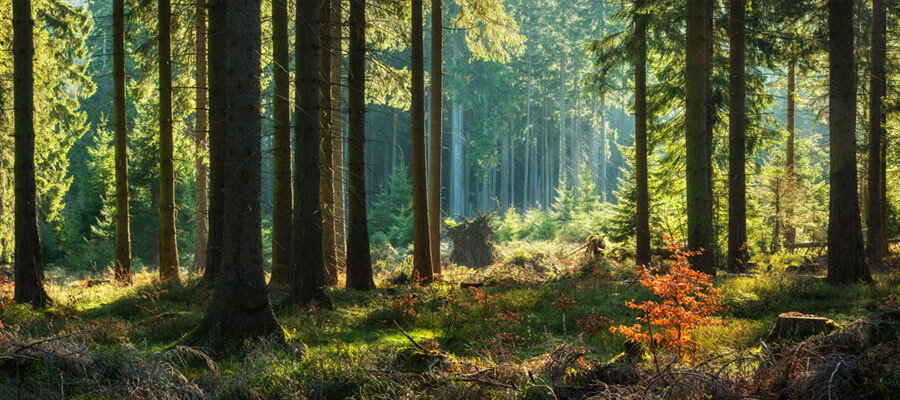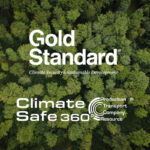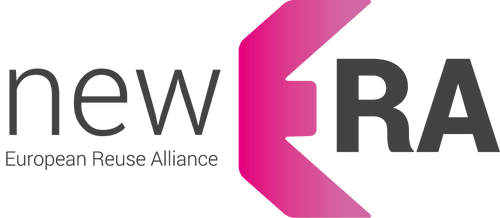The principle of sustainable forestry was developed to counteract the exploitation of forests. Almost one-third of Germany’s land area consists of forests, which fulfill many functions for humans and the environment. Wood is an important raw material for the production of various products – it is natural, constantly renewable, and versatile. This makes it an important economic factor. However, forests also have many social and ecological functions that need to be preserved.
The forest ecosystem provides habitat for animals and plants, protects the soil from erosion and floods, and has a climate-regulating function as a noise and dust filter. We humans use the forest for free as a source of recreation, tourism income, and as a raw material supplier for energetic wood use. Thus, various interests and needs come into play regarding the forests, which do not always have the preservation of the green lungs in mind. For this reason, various instances take care of preserving the regenerative capacity of the forests to ensure sustainable action.
Horst and Hain, Hag and Gehölz, Buschwerk, Tannicht, and finally just forest – the selection of distinctive terms in the vernacular for the forest is large. Some names can measure the size or type of the respective forest. Forest is a managed forest. The term ‘sustainable forestry’ therefore consists of the word ‘forest’ and the intention to preserve its natural regenerative capacity.
What is sustainable forestry?
FOREST EUROPE is the pan-European and voluntary policy process for the sustainable management and protection of forests. Founded in 1990, the 46 member states and the European Union have been developing strategies for the protection and sustainable management of forests together since then. In the context of this collaboration, overarching criteria have been determined. These include:
- Conservation and appropriate enhancement of forest resources and securing their contribution to global carbon cycles,
- Maintenance of the health and vitality of forest ecosystems,
- Conservation and improvement of the productivity of forests, ensuring, for example, the balance between logging and natural regeneration,
- Conservation, protection, and enhancement of biological diversity in forest ecosystems,
- Enhancement of the protective functions in forest management, particularly in the areas of water and soil,
- Maintenance of other socio-economic functions and conditions.
Sustainable forestry is not a specifically defined or protected term. Although forestry operations must comply with the legal requirements based on nature conservation laws, this does not mean that the management practiced is also sustainable. Furthermore, depending on the country and region, sustainable management of forests is voluntary. Thus, there are also numerous certificates and seals in the field of sustainable forestry that are established according to specific guidelines. The reusable products are made from lignocellulose sourced from sustainable forestry.

Why is a sustainability seal for forest management important?
According to the Federal Forest Inventory, around 11.4 million hectares in Germany are forested. That sounds like a lot at first, but it is relatively little compared to the former forest cover. Especially in recent years, German forests have struggled with severe drought. The water shortage makes the trees more susceptible to pests such as bark beetles. The handling of infested trees can exemplify the conflict of interest associated with the forest ecosystem. Here, economic and ecological goals collide, which must be harmonized to meet the criteria demanded by FOREST EUROPE. This is the case, for example, when diseased trees are felled and simultaneously processed for economic purposes. However, the sufficient regrowth of young trees must always be ensured.
Unfortunately, a balanced approach is not applied everywhere. Generally, more and more areas are being cleared for agricultural use. According to the Federal Ministry of Food and Agriculture (BMEL), 50 percent of Germany’s land area is used for agriculture, with 30 percent being forested. Although there are global projects to restore deforested and eroded areas like the Bonn Challenge, local organizations such as the Nature Conservation Association Germany e.V. (NABU) and municipalities also initiate reforestation projects. However, despite political support, they cannot do much to change the negative trend. In times of resource scarcity and climate change, it is therefore increasingly important to know where the raw materials come from and whether they have been adequately replaced.
Various certifications and seals are available to label products that come from sustainable forestry.
FSC® – The International Certification System for Sustainable Forestry
FSC stands for the Forest Stewardship Council, founded in 1993, and is an international certification system for sustainable forestry that aims to ensure important environmental and social standards in forests. The FSC is now active in over 80 countries. The ten principles and 70 criteria are globally valid for each FSC certificate issued.
These concern:
- Compliance with laws,
- Worker’s rights and working conditions,
- Indigenous people’s rights,
- Relationships with local communities,
- Forest benefits,
- Environmental impacts,
- Management activities,
- Monitoring and assessment measures,
- Special protection values of the forest, and
- Implementation of management measures.
Companies only receive an FSC certificate if they meet all the listed criteria and the annual audit by independent third parties is successful.
PEFC Seal – the “Forest TÜV“
PEFC stands for the “Programme for the Endorsement of Forest Certification Schemes” and is an independent institution to ensure sustainable forest management, which describes itself as a kind of global “Forest TÜV”. In many respects, the PEFC standard goes far beyond the legal requirements for forest management. Ultimately, this extra effort benefits nature. The PEFC guideline is equally aimed at implementing the three pillars of sustainability, namely ecological, economic, and social. The PEFC operates under strict guidelines and stands for an independently monitored and seamlessly traceable processing chain from the raw material to the finished end product. Furthermore, higher standards are set because the PEFC establishes many legal guidelines as shown in the following examples.
- Thus, PEFC forests must have biotope trees (deadwood and hollow trees). These are no longer economically usable but serve as habitats for protected insects and birds.
- When working with forestry machinery, accidents can occur, causing oil to leak and seep into the soil and water. For this reason, only biologically rapidly degradable chain oils and hydraulic fluids may be used in PEFC-certified forests. Health-damaging benzenes are also prohibited.
- Reforestation is important when there is damage to the forest due to natural phenomena such as storms, droughts, or pest infestations. Reforestation should therefore be done with high-quality plants tested by PEFC-recognized methods. This increases the likelihood that the trees will grow and remain healthy.
For more information on the respective seals, their measures, and objectives, visit the websites of the FSC and PEFC.







